We’ve all had the experience of visitors arriving just before, or just after, the best show of flowers/vegetables…the garden just isn’t looking its best the day they come, but it was right before (or after.) We once spent a small fortune watering a patch of bluebonnets, trying to keep it in flower in a drought year for my husband’s aunt, who–when shown them–said “Is that all? Why do people make a fuss over those?”
Well, we had houseguests this past week–late for one set of flowers and early for another–but the land graciously showed them something anyway:
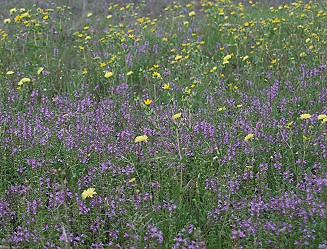 I have never seen, in the nine years we’ve owned the place, such a good showing of Prairie Brazoria, Warnockia scutellarioides. Like all our natives, it’s responsive to the exact weather conditions, and apparently it likes a hard, long drought followed by a rescue rain at exactly the right moment. The week before, I’d found some just coming into bloom:
I have never seen, in the nine years we’ve owned the place, such a good showing of Prairie Brazoria, Warnockia scutellarioides. Like all our natives, it’s responsive to the exact weather conditions, and apparently it likes a hard, long drought followed by a rescue rain at exactly the right moment. The week before, I’d found some just coming into bloom:
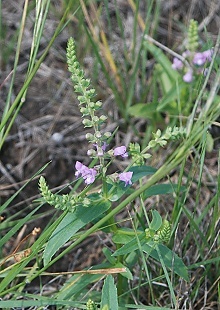
It’s a beautiful little plant individually, but in drifts with the yellow Pyrrhopappus and Texas star scattered above it, it’s quite a sight. It’s ankle-high, at most. It likes shallow soil (but not pure rock) and we have it mostly around the edges of the dry woods. I might try collecting seed this year and sow it in the wildflower garden back at the house.
Also out and about were the gravel-land plants that grow along the upper creekbed, out of, well, gravel. I’m very fond of two in particular, Showy False Foxglove and Prairie Larkspur.
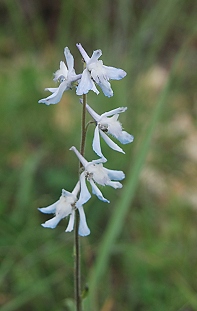
The Prairie Larkspur, Delphinium carolinianum, floats airilyabove the lower grasses, showing the muted but incredible colors you see in the pre-dawn sky for just moments, or in clouds after the sunset colors are gone but the light lingers.
More robust, but also gorgeous, is the Showy False Foxglove, Penstemon cobaea. The outside of the flower ranges from palest pink to deep lavender-rose, with the inside always snowy white but for the cleanly marked purple “bee-guide” stripes.
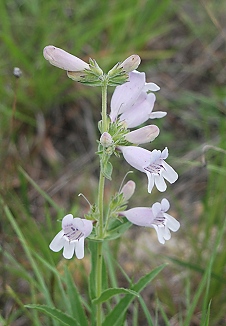
Also in bloom were sensitive briar, Englemann’s daisy, the first of our gaillardias, the first greenthread (which is yellow, for those of you not from Texas), mealy blue sage, spiderwort, and dayflower:
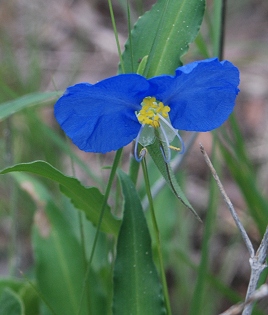
Astonishingly (to me, anyway) this Commenlina erecta grows up in the dry woods, on thin soil over rock, often in a clump of cactus. The flowers are large and brilliant blue.
I think our guests were pleasantly surprised.
Comment by Adrianne Middleton — May 10, 2009 @ 6:47 pm
Oooh! Ahhhh! Yummm!
Those are lovely E! All of them.
Ours aren’t blooming yet. Though I think I’ll have to hike out to the pasture and see how the bluestem (wild iris) is coming along since my domestics are just starting to flower.
A
Comment by Rosanne — May 10, 2009 @ 9:13 pm
Gorgeous!
Despite the fairly late frost, it’s looking like a really good year for greenery of all kinds. Barring mischance, we’re going to be giving away pounds and pounds of figs from our three backyard trees.
Living in town as we do, all of our greenery is cultivated. It’s soothing to see what the land gets up to, left unmolested.
Thanks for the updates and pics :o)
Comment by elizabeth — May 10, 2009 @ 9:51 pm
Rosanne, do you thin your figs? We have a very small fig tree by the carport, and it has lots of tiny green figs on it–but do they need thinning or will it self-thin, or what?
Comment by gunhilda — May 10, 2009 @ 10:38 pm
I’ve seen Prairie Brazoria blooming by the roadsides, but I didn’t know what it was. Now I do. Thanks! Gorgeous pics!
Comment by elizabeth — May 10, 2009 @ 10:51 pm
It looks a lot like miniature Obedient Plant, which also grows on roadsides but is taller. If it’s in a ditch and a foot or more tall, it’s probably Obedient Plant. If it’s on a very gentle slope, it’s probably this.
Comment by Rosanne — May 11, 2009 @ 7:09 am
We don’t thin them – our trees are mature enough that most of the fruit makes it to harvest. For a few years, we pruned to shape the trees into more of a traditional tree shape, but after a couple of years with hard frosts hurt them, we didn’t have the heart to chop away healthy branches. Now all three are in the normal fig tree shape – shoots from everywhere, forming a globe from the ground up. We take off any dead branches in the early spring, when we can tell which ones are really dead, and can still see them.
Two of our trees (sold to us as “Texas Brown,” but who knows?) have multiple clusters of small figs, while the other variety (sold to us as “Turkey Fig”) used to have single large figs, scattered along the branches. This year, it’s clustering, too. The large fig’s fruit has a problem with open ends, inviting ants and other bugs. The small figs’ fruit is closed.
Until the tree is mature, it may set fruit too early or too late, and lose it to frost. It’s a tough tree in warm regions. Our dogs chewed one 3-ft-high youngster to within four inches of the ground, and it came back. Now it’s about ten feet tall, shooting for twelve.
I’ve seen comments that it grows and fruits better if not overly pampered, and that the roots should be somewhat constricted. We have clay soil, and just mulch the trees to help conserve moisture.
Comment by gunhilda — May 11, 2009 @ 4:01 pm
Hard to guess the height without wading into the grass, but they were on dry sloped or flat-ish areas, definitely not ditches.
This is the first time I’ve noticed these flowers in such masses on the roadside in SW Oklahoma. This was a couple weeks ago.